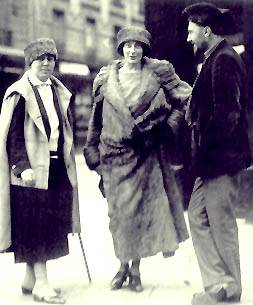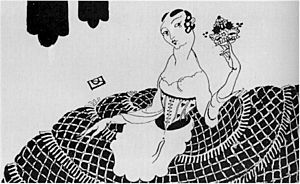Mina Loy facts for kids
Quick facts for kids
Mina Loy
|
|
|---|---|

Mina Loy in 1917
|
|
| Born |
Mina Gertrude Löwy
27 December 1882 London, England
|
| Died | 25 September 1966 (aged 83) Aspen, Colorado, US
|
| Occupation | Writer: poet, playwright, novelist; actress, designer, painter |
| Movement | Modernism, Futurism, Dadaism, Surrealism |
| Spouse(s) | Stephen Haweis (1903 - divorced 1917, separated years beforehand), Arthur Cravan (25 January 1918 -) |
| Children | 4 |
Mina Loy (born Mina Gertrude Löwy; 27 December 1882 – 25 September 1966) was a talented British artist and writer. She was a poet, playwright, novelist, painter, and even designed lamps. Mina Loy was part of the modernist movement, which was a big change in art and writing. Many famous writers like T. S. Eliot and Ezra Pound admired her poetry. She was known for being very original and unique in her work.
Contents
Early Life and Art School
Mina Loy was born in London, England. Her father, Sigmund Felix Lowy, was a Hungarian Jewish tailor who moved to London to escape unfair treatment. Her mother, Julia Bryan, was English and Christian. Their marriage was difficult.
Mina felt that her mother was very strict and old-fashioned. Her mother didn't like Mina's imagination and often punished her. Mina found it hard to connect with her mother, who also held strong beliefs about the British Empire and was unfair to her father because he was Jewish.
In 1897, Mina started her art education at St. John's Wood School. She didn't enjoy it much, calling it "the worst art school in London." Her father wanted her to go to art school so she would be more likely to marry. Around this time, Mina became very interested in the artists Dante Gabriel Rossetti and Christina Rossetti, and the Pre-Raphaelites.
Studying Art in Europe
In 1900, Mina went to an art school in Munich, Germany, where she learned how to draw well. When she returned to her family home in London, she felt unwell and tired. This was called "neurasthenia" at the time, a term for feeling run down, especially for creative people.
Around age eighteen, Mina convinced her parents to let her study art in Paris. In 1902, she moved to Montparnasse and attended the Académie Colarossi. Here, she met Stephen Haweis, an English painter. Mina later described him as someone who took her energy. Stephen was not popular with other students, but Mina felt sorry for him. He borrowed money from her and made her feel guilty for not liking him.
Marriage and Family in Paris
Mina and Stephen Haweis got married in Paris on 13 December 1903. Mina was twenty-one and expecting a baby. They first agreed it would be a marriage of convenience, but Stephen quickly became more demanding. After marrying, she changed her last name from "Lowy" to "Loy."
Stephen started selling art photographs, and Mina was often his favorite subject. Mina's first child, Oda, was born on 27 May 1903. The birth was very difficult. Sadly, two days after her first birthday, Oda died from meningitis. Mina was heartbroken.
In 1905, Mina decided to show her art in Paris under the name "Mina Loy." She exhibited six watercolors. The next year, she showed two more. She was recognized as a talented artist, which was a great achievement for a young Englishwoman. By 1906, Mina and Stephen decided to live separately.
Life in Florence
Mina and Stephen moved to Florence, Italy, in 1906. They joined a large community of people from other countries. On 20 July 1907, Mina gave birth to her second child, Joella Sinara. A few months later, she became pregnant again with Stephen's child, a son named John Stephen Giles Musgrove Haweis, born on 1 February 1909.
Joella was slow to learn to walk. Doctors later found she had a type of paralysis. Mina worried it was like the illness that killed Oda. She found help through Christian Science, which improved Joella's health.
Mina spent less time with her children as they grew older. They were often cared for by a nurse and cook. Mina often went to social gatherings and met famous people like Gertrude Stein. Gertrude Stein admired Mina's ability to understand new ideas in poetry.
From 1914 to 1916, Mina was involved with the Futurist art movement in Italy. She met Italian artists like Carlo Carrà and Ardengo Soffici. Mina was the only British artist to show her work in the First Free Futurist International Exhibition in Rome in 1914.
Feminist Manifesto
Around 1914, while living in Florence, Mina Loy wrote her Feminist Manifesto. This was a strong statement against how women were treated in society. It was not published during her lifetime.
Moving to New York
Mina became tired of the aggressive parts of Futurism. She wanted more independence and to be part of the modern art scene in New York. In 1916, she left her children and moved to New York. She quickly became an important figure in the art community, especially with Others magazine. She met artists like Man Ray, William Carlos Williams, and Marcel Duchamp. Mina became well-known in the Greenwich Village art scene.
In 1917, Mina acted in a play called Lima Beans with William Carlos Williams. She also showed a painting called Making Lampshades at the first exhibition of the Society of Independent Artists. This show was special because it had "no jury, no prizes," meaning anyone could show their art.
In 1917, she met Arthur Cravan, a "poet-boxer" and nephew of Oscar Wilde's wife. Arthur went to Mexico to avoid being drafted into the army. After her divorce was final, Mina followed him, and they married in Mexico City in 1918. They lived in poverty there.
When Mina found out she was pregnant, she traveled to Buenos Aires to wait for Arthur. But Arthur never appeared and was never seen again. He was thought to have drowned while testing a boat. Their daughter, Fabienne, was born in England in April 1919. Mina later wrote about her relationship with Arthur in her memoir, Colossus.
Return to Europe and New York

After Arthur Cravan's disappearance, Mina returned to England, then to Florence to be with her other children. She later moved back to New York in 1916. She worked in a lamp-shade studio and acted in plays. She continued to write poems that appeared in small magazines like Little Review and Dial. She became friends with writers like Ezra Pound and Jane Heap.
In 1923, Mina returned to Paris. Her first book of poetry, Lunar Baedecker, was published that year. It included her famous "Love Songs."
Later Life and Art
In 1936, Mina Loy moved back to New York and lived with her daughter. She found inspiration for her poems and art from the people she met in the Bowery neighborhood. She became a citizen of the United States in 1946. Her second and last book, Lunar Baedeker & Time Tables, came out in 1958.
In 1953, Mina moved to Aspen, Colorado, where her daughters lived. Her daughter Joella married the artist Herbert Bayer. Mina showed her "found object" art (art made from everyday items) in New York in 1951 and at the Bodley Gallery in 1959.
Published Works
Mina Loy's poetry was published in several magazines before becoming books. She had two poetry books published during her life: The Lunar Baedeker (1923) and The Lunar Baedeker & Time-tables (1958). After she passed away, more collections of her poetry were released.
Her only novel, Insel, was published in 1991 after her death. It is about the relationship between a German artist and an art dealer.
Mina Loy's Children
Mina Loy had four children. Her children with Stephen Haweis were Oda Janet Haweis (1903–1904), Joella Synara Haweis Levy Bayer (1907–2004), and John Giles Stephen Musgrove Haweis (1909–1923). Her only child with Arthur Cravan was Jemima Fabienne Cravan Benedict (1919–1997).
Sadly, Oda died at one year old from meningitis. Giles died at fourteen from a rare illness. His father had taken him away from Florence without Mina's permission. Mina never saw Giles again before he died. These losses were very hard for Mina.
Death and Legacy
Mina Loy continued to write and create art until she passed away at age 83 on 25 September 1966, from pneumonia in Aspen, Colorado. She is buried in Aspen Grove Cemetery.
Recently, her work has been translated and shared in Latin America, helping more people discover her important legacy.
List of Works
Poetry Books
- Lunar Baedeker (Paris: Contact Publishing Co.,1923)
- Lunar Baedeker and Time-Tables (Highlands, N.C.: Jonathan Williams Publisher [Jargon 23], 1958)
- The Last Lunar Baedeker, Roger Conover ed. (Highlands: Jargon Society [Jargon 53], 1982)
- The Lost Lunar Baedeker, Roger Conover ed. (Carcanet: Manchester, 1997)
Published Prose
- Insel, Elizabeth Arnold ed. (Black Sparrow Press, 1991)
- Stories and Essays, Sara Crangle ed. (Dalkey Press Archive [British Literature Series], 2011)
Art Exhibitions
- Salon d'Automne (Paris, 1905) – six watercolours
- Salon des Beaux Arts (Paris, 1906) – two watercolours
- First Free Futurist International Exhibition (Rome, 1914)
- The New York Society of Independent Artists (Inaugural exhibition, 1917)
- Constructions at Bodley Gallery, New York (April 14 – 25th 1959; her only solo show)
See Also
 In Spanish: Mina Loy para niños
In Spanish: Mina Loy para niños


